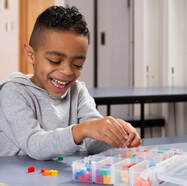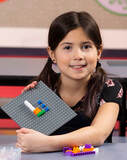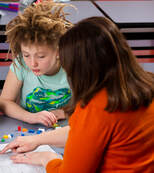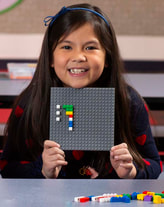 Brick Math is proud to announce our brand-new 7th - 8th grade content with two new subjects added to the curriculum: Pre-Algebra and Data and Statistics. As with all the Brick Math curriculum, the content is taught by modeling the math with LEGO® or LEGO®-compatible bricks, giving students a hands-on experience that helps them gain deep understanding of the mathematical concepts. Each subject has a Teacher Edition that guides the teacher through the step-by-step lessons as well as a Student Edition that is a workbook for students to draw their brick models and includes student assessments for every chapter. The Brick Math brick set works for these new subjects, too.  The new content extends Brick Math to a complete K - 8 curriculum solution for schools as well as for homeschooling. Brick Math is ideally suited for students who haven’t been able to learn the concepts through more traditional methods.  In Pre-Algebra, students are introduced to topics that help them prepare for high school math. These include integers, fractions, square roots, step equations, linear equations, and decimals. Students learn how to solve basic equations using variables. Modeling with bricks, students engage in problem-solving activities that expand their knowledge of: • absolute value and positive/negative numbers • exponents, including negative exponents and multiplicative inverse • rules of integers • algebraic expressions • equations and inequalities • slope  In Data and Statistics, students learn the basics of representing and interpreting data with line plots, bar graphs, histograms, and box plots. They learn how to measure central tendency through mean, median, mode, and range. Then students move on to learn about coordinates, line graphs, and scatter plots. Finally, they learn how to graph and calculate the slope of a line. The final chapter is an introduction to both theoretical and experimental probability. Modeling with bricks, students engage in problem-solving activities that expand their knowledge of: • visual models and graphs of data sets • measures of central tendency • coordinate grids • slope • theoretical and experimental probability Both books progress through these topics in modules, moving from more basic to more complex in each chapter. Most students learn these Pre-Algebra and Data and Statistics topics in grades 7 - 8. We have had so many requests to extend the Brick Math program through eighth grade, and it’s finally here! We’re excited to share the new Brick Math content with you. Brick Math is a K-8 math curriculum that uses LEGO® bricks to model 13 different math subjects:
Counting, Addition, Subtraction, Multiplication, Division, Basic Fractions, Basic Measurement, Fraction Multiplication, Fraction Division, Advanced Measurement and Geometry, Decimals, Data and Statistics, and Pre-Algebra. Brick Math works in many applications: for homeschooling, math intervention, enrichment, and as a whole-school program. Materials are simple and affordable. If you are a math teacher or a parent with a student at home who is learning K-8th grade math, check brickmath.com. The website includes videos for both teacher training and direct instruction of students. You can learn more about how Brick Math improves students' math test scores and hear what people who are using Brick Math have to say about the program.
0 Comments
 Image by rawpixel.com on Freepik Image by rawpixel.com on Freepik "April showers bring May flowers." April's Lesson of the Month on Decomposing Numbers in Addition brings May's Lesson of the Month on...Decomposing Numbers in Subtraction! To get the May 2023 Brick Math Lesson of the Month, "Decomposing Numbers / Place Value," plus a new lesson each month, click here. Each Lesson of the Month includes the Teacher Lesson Guide as well as the Student Workbook pages that correspond to the lesson.  This lesson, from Brick Math's Subtraction Using LEGO® Bricks, models decomposing one ten into ten ones for the purpose of solving a subtraction problem. It also helps students understand the concept of place value, clearly showing bricks that represent both the tens and the ones places. It's a great way to explain what it actually means to subtract 8 from 22, which can be a difficult idea for some students to grasp when they start learning to subtract.  Brick Math is a K-6 math curriculum that uses LEGO® bricks to model 11 different math subjects: Counting, Addition, Subtraction, Multiplication, Division, Basic Fractions, Basic Measurement, Fraction Multiplication, Fraction Division, Advanced Measurement and Geometry, and Decimals. This year, the program will expand to include grades 6 - 8, with the additional subjects Data and Statistics, Pre-Algebra, and Ratios and Proportions. Brick Math works in many applications: for homeschooling, math intervention, enrichment, and as a whole-school program. Materials are simple and affordable.  If you are a math teacher or a parent with a student at home who is learning K-8th grade math, check brickmath.com. The website includes videos for both teacher training and direct instruction of students. You can learn more about how Brick Math improves students' math test scores and hear what people who are using Brick Math have to say about the program.  This Brick Math Lesson of the Month is from a new book not yet out — Data and Statistics Using LEGO® Bricks. The book will be published this spring as part of the expansion of the Brick Math curriculum into grades 6 - 8. To get the March 2023 Brick Math Lesson of the Month, "Representing Data," plus a new lesson each month, click here.  This lesson is the first one you'll use to teach students what data sets are and how to represent them graphically and with bricks. This is part of the K-2 math curriculum in most schools. The lesson introduces the terms data point, data set, and analyze, which are all important vocabulary words to understand when learning about data. The lesson uses three different colors of bricks to represent attributes of the data, and it uses the studs on the bricks to track the number of data points within each category of data.  The lesson also connects to the math symbols <, >, and = . As soon as they are introduced to the subject, students learn to analyze data both in words and through math sentences. Brick Math is a K-6 math curriculum that uses LEGO® bricks to model 11 different math subjects:
Counting, Addition, Subtraction, Multiplication, Division, Basic Fractions, Basic Measurement, Fraction Multiplication, Fraction Division, Advanced Measurement and Geometry, and Decimals. This year, the program will expand to include grades 6 - 8, with the additional subjects Data and Statistics, Pre-Algebra, and Ratios and Proportions. Brick Math works in many applications: for homeschooling, math intervention, enrichment, and as a whole-school program. Materials are simple and affordable. If you are a math teacher or a parent with a student at home who is learning K - 8th grade math, check brickmath.com. The website includes videos for both teacher training and direct instruction of students. You can learn more about how Brick Math improves students' math test scores and hear what people who are using Brick Math have to say about the program.  Math scores for students across the US have declined since the start of the pandemic, according to the most recent National Assessment of Educational Progress (known as the “Nation’s Report Card”). For fourth graders, only 36 were found proficient in math. Even worse were the scores for eighth graders: only 26 percent proficient in math. The term “proficient” means that the students have demonstrate competency in the subject matter in their grade level.  What does this mean for schools? Students need to focus on academic recovery. Students need to get back their math knowledge, and fast. Since math instruction builds on what students have previously learned, more and more students will be set back if they aren’t given the tools to catch up first.  Brick Math is a perfect solution for schools, teachers, and parents who want to help their elementary and middle school students catch up in math. Brick Math teaches 11 subjects of basic math using LEGO® bricks. Modeling math with bricks helps students understand what the math means. The program is perfect for students who are struggling and haven’t learned through other teaching methods. It’s adaptable to all learning environments: whole-class instruction, small groups, and individual tutoring.  The school district of Davidson County, North Carolina, recently brought in Brick Math throughout the district to help bring their students back to levels of math proficiency. According to Dr. Deana Coley, Assistant Superintendent of Curriculum and Instruction for the district, “We asked our teachers which program students would have the most success with, and overwhelmingly, the teachers requested Brick Math.”  Brick Math is a K-6 math curriculum that uses LEGO® bricks to model 11 different math subjects: Counting, Addition, Subtraction, Multiplication, Division, Basic Fractions, Basic Measurement, Fraction Multiplication, Fraction Division, Advanced Measurement and Geometry, and Decimals. It works for math intervention, enrichment, as a whole-school program, and even homeschooling. Materials are simple and affordable. If you teach math or have a student at home who is learning K - 6th grade math, check brickmath.com. The website includes videos for both teacher training and direct instruction of students. You can learn more about how Brick Math improves students' math test scores and hear what people who are using Brick Math have to say about the program.
 We get lots of questions from parents who want to try Brick Math with their children, either for homeschooling or as a fun supplement at home. They often ask how to determine where their child should start, what books to purchase, and what bricks to use. Here's a guide to getting started with Brick Math: Brick Math basics: Brick Math is based on teaching individual math subjects. The series starts with Counting and Cardinality, and works its way up to Advanced Measurement and Geometry. There are 11 subjects available that track the typical K - 6 curriculum. You can view all of them here: https://www.brickmathseries.com/products.html To get a sample lesson of any subject, click on the subject, click on any version of the book, then click "Download Sample Lesson" or "Look Inside!"  Determining what subjects to start with: If your child has already starting learning with another math curriculum, determine what he/she has mastered and move on from there. For example, the typical K-2nd grade curriculum includes Counting, Addition, and Subtraction, plus part of Basic Measurement (telling time). If your child has mastered those, move to the subjects that are typically in the 3rd-4th grade curriculum: Multiplication, Division, and Basic Fractions, plus most of Basic Measurement. Teacher and Student Editions: We suggest you buy the Teacher and Student Edition of each subject. You will use the Teacher Edition to guide your child through the lessons, and your child will use the Student Edition to draw their brick models, answer questions, and complete chapter assessments, so you will feel confident that they are ready to move on. Each child learning with Brick Math needs their own Student Edition. Print books or PDFs: Either version will work, but you will need to print out all the pages of the Student books for your child to write in. The books average about 80 pages in length. The books are in full color so the illustrations of the brick models are easy to understand. This is more important for the Teacher books, which include illustrations of the brick models you will make as teacher, and of the models you can expect your child to make. Since many people don’t have easy access to a color printer, or find color printing much more expensive, the print book may be a less expensive alternative to a PDF if you plan to print out most of the pages.  Bricks needed: You can use your own LEGO bricks if you have plenty of them, or you can buy our Brick Set, which includes all the bricks needed for the entire Brick Math program. Every chapter has a list of all the bricks you need for that chapter, and there is a suggested brick inventory for the whole program in each book and on our website at https://www.brickmathseries.com/uploads/7/1/0/2/7102647/brickinventory.pdf. More resources: The Brick Math website includes lots of videos to help you get comfortable with the program and see the Brick Math method being taught by the author of the series.
https://www.brickmathseries.com/videos.html For additional information, check the website section for parents/homeschool: https://www.brickmathseries.com/for-parentshomeschool.html  Many homeschool families are using Brick Math: Teaching Math Using LEGO® Bricks for the math curriculum for their children ages 5 – 12, or in grades K – 6. We recently gave a short virtual presentation about Brick Math to interested parents associated with the Heartwood Charter School, a public charter school for independent study in California. Watch the video to see how Brick Math works for homeschool families. If you homeschool your child and are looking for math curriculum, this video presentation about Brick Math shows you the materials, explains how you can get started, and gives a short demonstration of a lesson. You can check the website for more information about how Brick Math can work for you and your child. Please feel free to contact us if you have more questions about Brick Math as a homeschooling math curriculum.
 The August 2021 Lesson of the Month comes from the Decimals book. To get the August 2021 Lesson of the Month, plus a new lesson each month, click here. For the first time, we’re showing you Part 2 of a lesson, or “Show What You Know.” This comes after the teacher has demonstrated the skill in Part 1 of the lesson (“Show Them How”), with the students working along with their own bricks. In Part 2, the teacher poses a problem for the students to work out while the teacher observes and coaches.  In Part 1, students have learned how to model decimals in a 100 x 100-stud decimal grid. In Part 2, students are first asked to model 0.42 in a decimal grid with bricks. Next, they are asked to try modeling any combination of studs that adds up to 0.30. In the Decimals book, the example illustrated is 0.14 + 0.16. The 100 x 100 decimal grid is a very useful tool to explain the concept of decimals to the one-hundredth place. Author of the Brick Math series, Dr. Shirley Disseler, demonstrates how to teach this decimal addition lesson in a one-minute Brick Math video, which is also part of the August 2021 Lesson of the Month. Watching the videos on the website really helps a teacher or parent understand how to guide a student through the Brick Math curriculum. Brick Math is a K-6 math curriculum that uses LEGO® bricks to model 11 different math subjects: Counting, Addition, Subtraction, Multiplication, Division, Basic Fractions, Basic Measurement, Fraction Multiplication, Fraction Division, Advanced Measurement and Geometry, and Decimals. It works well for homeschooling, math intervention, enrichment, and as a whole-school program. Materials are simple and affordable. If you teach math or have a student at home who is learning math, check brickmath.com. The website includes videos for both teacher training and direct instruction of students. You can learn more about how Brick Math improves student math test scores and hear what people who are using Brick Math have to say about the program.  Happy summer to everyone! It's been a looooong school year for teachers, students, and parents—not one we hope to repeat again! Here's a new Brick Math Lesson of the Month for you to try. We think the Brick Math program will be especially helpful in the upcoming school year for kids who have lost some math skills during the pandemic year.  The Brick Math Lesson of the Month for July 2021 is on Division Basics. It's a great way to introduce the concept of division to a student. The lesson uses LEGO bricks to model three basic division problems: 4 ÷ 2 = 2; 8 ÷ 4 = 2; and 6 ÷ 3 = 2. When a student builds the problems with bricks and counts the studs on each brick, the idea of division is made simple to learn. To get the July 2021 Lesson of the Month, plus a new lesson each month, click here. The lesson is accompanied by a short video that illustrates the brick building process for each problem. Watch it before you teach the lesson to your student(s), or watch it along with your student(s)!  Brick Math is a K-6 math curriculum that uses LEGO® bricks to model 11 different math subjects: Counting, Addition, Subtraction, Multiplication, Division, Basic Fractions, Basic Measurement, Fraction Multiplication, Fraction Division, Advanced Measurement and Geometry, and Decimals. It works well for homeschooling, math intervention, enrichment, and as a whole-school program. Materials are simple and affordable. If you teach math or have a student at home who is learning math, check brickmath.com. The website includes videos for both teacher training and direct instruction of students. You can learn more about how Brick Math improves student math test scores and hear what people who are using Brick Math have to say about the program.  Many parents and teachers face a difficult dilemma. Research shows that children are finding it tough to learn math concepts during the pandemic. All the evidence points to 2020 as a year when many children will be falling behind in learning basic math.  The good news: there is a way to supplement students’ math instruction—and make it fun so kids will enjoy learning! It’s called Brick Math: Teaching Math Using LEGO® Bricks. Brick Math incorporates the LEGO® bricks that kids love and uses them to teach elementary school math concepts in a fun and exciting way. But it’s not a gimmick—Brick Math is a serious learning method, backed up by research and rigorous testing. Brick Math works as a supplement to other math curriculum because the program is modular. There are 11 different subjects covered in the program that spans grades K – 6:
 Here’s how Brick Math works: Choose the subject area that your students need. For example, if they are having trouble understanding the idea of fractions, the Basic Fractions Using LEGO® Bricks books zero in on that topic. The Teacher Edition has all the lessons that can be taught by a teacher or parent, and the Student Edition is the work-along book for the student, with additional problems, chapter assessments, and a chart to track the student’s progress. The 250-piece Brick Set has all the bricks for every math subject, and basic LEGO® bricks work if you have them already. Kids really enjoy learning with Brick Math. “My class will often choose doing more Brick Math rather than recess,” was a comment from a fourth-grade teacher. A homeschooling parent told us, “My son was struggling with understanding quarts, pints, and gallons until we tried Brick Math. He loves LEGO bricks, and now he builds and remembers math problems!”
For more information about how Brick Math works, visit BrickMath.com. You’ll find videos for students and teachers or parents, plus samples from each of the 11 subjects to help you decide which books are right for your students.  What makes a math curriculum right for homeschooling? There are several factors to consider when you’re searching for the best way to help your child learn math. 1. Student Engagement The best teaching methods work when students enjoy the learning process. Research has shown that “time on task” is a critical element in determining educational success. The longer a student will stay with a task while learning, the more the student will learn. Brick Math is #1 in student engagement. Kids love to use LEGO bricks to learn K – 6th grade math! The process of building math models with LEGO bricks keeps students engaged with the program, which results in learning.  2. Practical Application Math is a conceptual subject, which can make it harder for some kids to learn. Experts agree that finding ways to make math concrete through representation of the math with manipulatives substantially increases a student’s understanding of the math. The entire Brick Math program has been created to make math real and tangible to students, by modeling the math with LEGO bricks. Students who learn with Brick Math often say, “Now I understand the math! I can see it!”  3. Modular Program Math is a subject that builds on prior knowledge. For example: if you haven’t memorized the multiplication tables, you will have trouble understanding factors, and will then be mystified when trying to find the lowest common denominator. Brick Math is built in 11 modules, ranging from Counting and Cardinality in the early years, through Advanced Measurement and Geometry around grades 5 – 6. You can bring in any of the 11 Brick Math modules when your child is ready to learn that subject. Many parents use Brick Math to reinforce a math subject that their child has not learned fully from another math curriculum.  4. Easy to Teach When you are homeschooling your child, you need to be comfortable with the material so you can teach it properly. And especially with math, the teaching methods used when you were younger are not the ones being used today. Brick Math makes the teaching process easy for parents to use. The Teacher Edition of each subject has step-by-step lessons that you follow to teach the topic. There are illustrations of all the brick models you will build, as well as illustrations of the correct models that the student will build, so you’ll know they are learning. Short videos on the Brick Math website show you exactly how Brick Math works, so you’ll feel very confident when you work with your child on the lessons. You’ll know your child is learning, because the Student Edition for each subject includes an assessment in every chapter and a chart to track your child’s progress.  5. Affordable Homeschooling materials can be very pricey, and when you need to buy a new curriculum every year, the cost of so many programs can be prohibitive. Brick Math is a very affordable curriculum: One Teacher Edition ($14.95) and one Student Edition ($9.95) per math subject (less than $25 for each subject). Use the LEGO bricks you already own, or get a Brick Math brick set for $60, which includes all 250 bricks needed for all 11 subjects, plus two 6” x 6” baseplates, packed in a sturdy divided storage box for easy access and clean-up. That’s a total of less than $80 to get started, then $25 to add on new subjects.  6. Based on Sound Academic Research and Practices When selecting homeschooling curriculum, look for programs that are based on the most up-to-date academic research and ideas. Especially in math, you want to be sure your child’s curriculum is keeping up with the latest information. Brick Math was developed by Dr. Shirley Disseler of High Point University, an expert in math education and learning using LEGO bricks. She created the program based on the current findings into how students learn math. The Brick Math program has been tested with thousands of students, and has been shown to be highly effective at helping students learn math in the elementary school years. Parents across the US have been astonished to discover how well their children learn math with Brick Math after trying in vain to learn from other methods. Brick Math is a K-6 math curriculum that uses LEGO® bricks to model 11 different math subjects:
Counting, Addition, Subtraction, Multiplication, Division, Basic Fractions, Basic Measurement, Fraction Multiplication, Fraction Division, Advanced Measurement and Geometry, and Decimals. If you have a student at home who is learning math, check brickmath.com. The website includes videos for both teacher training and direct instruction of students. You can learn more about how Brick Math improves student math test scores and hear what people who are using Brick Math have to say about the program. |
Categories
All
Archives
July 2024
|


